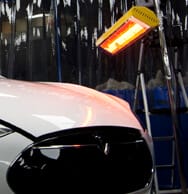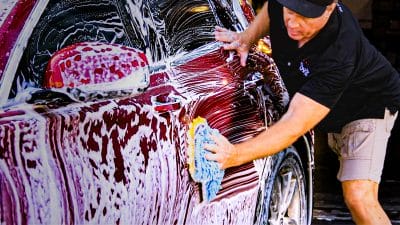Last Updated May 17, 2023
We’ve recently received a number of inquiries via Instagram (@drbeasleys) from detailers across the U.S. regarding infrared curing for nano coatings. Even though infrared is generally a pretty boring topic if you’re not a scientist, we’re going to spice it up by addressing it within the context of car detailing. To begin, we kind of have to give a basic definition of infrared as a concept. Infrared (IR) is a type of radiation that is part of the electromagnetic spectrum. It is a way in which heat is transferred and can be felt but not seen by humans. Anything that has a temperature is emitting infrared radiation, even ice cubes. Did you read that? Even ice cubes emit IR. Isn’t that COOL? (No, it’s not) Anyway, let’s get into it.
1. When you would need IR: If you work in or own a body shop, you likely already have IR because it’s used to cure paint during repainting. For those of you who own or work in professional detailing shops, or those of you who do mobile detailing, you know how stressful it is when your schedule is packed and you feel like you don’t have nearly enough time to get everything done. IR comes in handy when you’re faced with deadlines because it expedites the curing process. The faster the curing, the less time available for damage caused by the curing environment.
2. Know what type of IR you need: So maybe you’re a detailer with tons of customers (go you!) and you want to invest in IR lamps to help keep the cars moving through quickly. You should definitely know what type of infrared lamp(s) you want to get.

There are 3 types of infrared, all of which can be channeled through lamps: long wave, medium wave, and short wave. Long wave is the least efficient. We don’t even need to talk about it because it’s irrelevant to our industry. Medium wave IR lamps are good for curing coatings on simple surfaces like hoods and roofs. Short wave is the most efficient IR for detailing because it cures coatings the fastest. It’s strong as heck and can be used on complex part shapes like side mirror housing and lower fascia areas.
3. Know the numbers: At Dr. Beasley’s, we use IR lamps from Infratech Automotive. We have a small lamp that cost about $300 (SR 2) that we use constantly. We also have a large one that cost around $3000 (SR 6000) that we use less frequently. Both are shortwave. We use them to cure nano coatings like our Nano Resin. The large lamp covers areas of 4′ by 6′ and can be used to cure higher surfaces like SUV roofs. You can also customize the heat cycle on the SR6000. Honestly, you probably don’t need the big one. It’s expensive and takes up a decent amount of space, while the little guy does a great job and conveniently tucks into a corner when unused.

4. You don’t need it to cure coatings on matte paint: Being that we’re matte experts, we had to include some info for our fellow matte lovers. Of course IR curing is used during the process of painting a matte car, but it is absolutely unnecessary to use for coating application. Why would you use a glossy nano coating on a matte car anyway? You wouldn’t! You would only use a matte specific sealant to coat your shine-free vehicle. A solid matte sealant will bond instantly.
5. Make sure you do need it at all: You don’t necessarily NEED IR lamps. Most coatings are designed to cure regularly, with time. Be aware that different climates effect coatings in different ways. IR curing is not the end all be all for coating application, it’s just a neat addition to your already efficient detailing shop. Also, most shops have a designated curing area to prevent damage. If you don’t have an area like this, try to create one. If you’re a mobile detailer, it probably doesn’t make a ton of sense to lug around a bunch of lamps.

Final Thoughts If you do use IR, make sure you’ve done your research; make sure you need it. If you’re already coating cars without it and you like the results, don’t even worry about it. If you have tight deadlines, if you have a customer who requests IR curing for their coating, or if you just want to have an IR lamp in your shop, go for it. Invest first in a smaller model and make sure it’s either medium or short wavelength. Last but certainly not least, and of course all of you already know this because you’re experts, never EVER use IR near anything flammable. Be safe out there and get your cure on!





Is there information on cure times for silicon dioxides? Maybe a graph? I read on only forums it takes about 15minutes per panel to cure, does that info sound consistent?
What paint curing system will heat the interior to off-gas it but not damage leather seats?